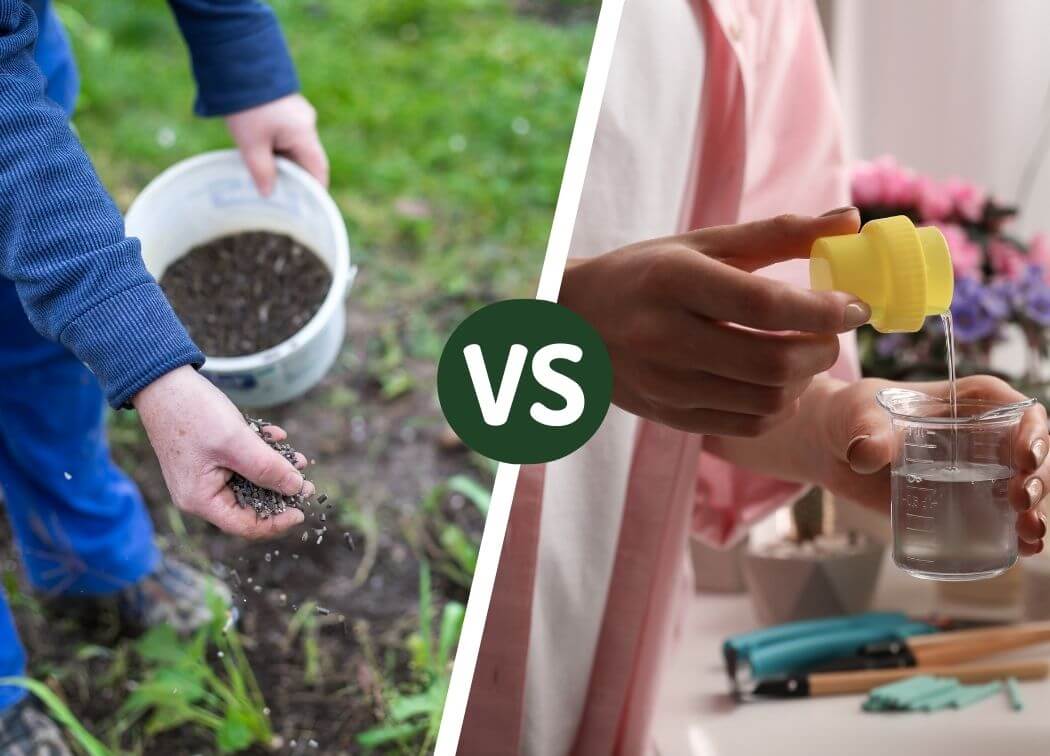Homeowners often have trouble picking between the two main kinds of fertilizer: Liquid and Granular.
Choosing between Granular vs. Liquid lawn fertilizer will depend on the grass types you’ve planted, plus how long you’re willing to wait for results. Whether you choose granular or liquid, they pack the same nutrients for your lawn. The only real difference is that liquid fertilizers release their nutrients way faster than granular ones.
Differences between Liquid and Granular Fertilizer
Liquid and Granular fertilizers have four main differences: their cost, application methods, effective speeds, and how long they can be stored.
Here’s a brief breakdown:
- Cost: Granular fertilizers are typically cheaper than their liquid counterparts
- Application Methods: You’ll need a hose to apply liquid fertilizers and a spreader for granular fertilizers.
- Release Speed: Liquid fertilizers release their nutrients faster than granular, slow-release fertilizers
- Lifespan: Granular fertilizers can be stored for much longer than liquid fertilizers.
Overall, if you want to save money and you live in a hotter area, go for granular fertilizer. But if you don’t have the time to use a spreader, go for liquid fertilizer.
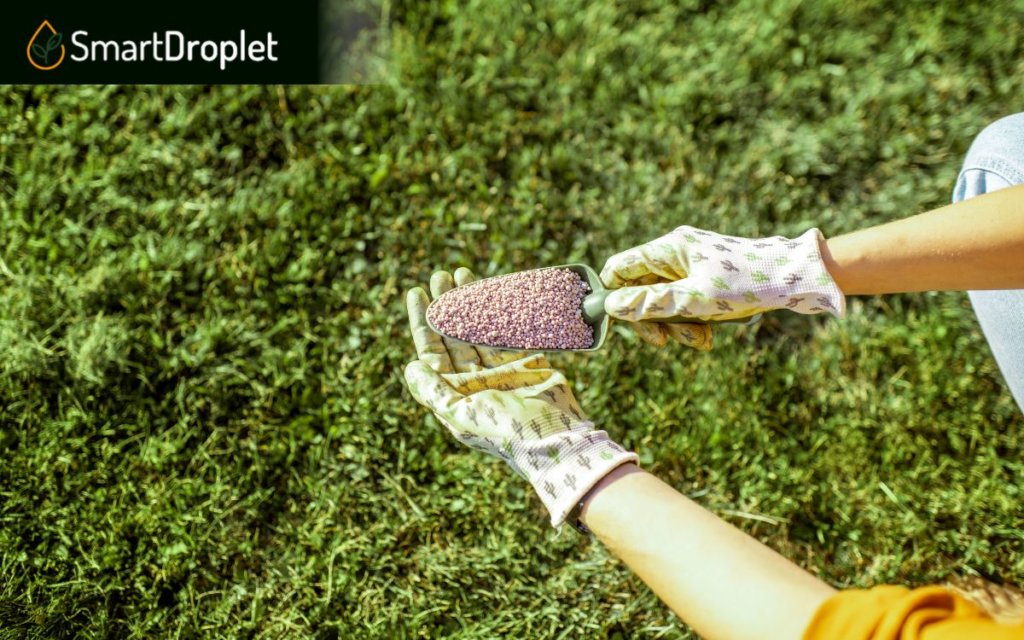
Granular Fertilizers Explained
Also known as “dry fertilizers,” these fertilizers come in the form of beads and pellets.
They’re not just usable on grasses. You can find granular fertilizers that are blended for other plants, too.
Most dry fertilizers are slow-release, but there are a few quick-release granular products you can find.
The Advantages of Granular Fertilizers
There are a few notable benefits surrounding dry fertilizers as a choice. Here are some granular fertilizer pros:
Cost-Effective
As mentioned earlier, granular fertilizers are cheap. You can pick them up in the medium to large-sized bags or bottles, and a single pass over your lawn can cost you less than $20.
Even if you need to pick up a spreader because you have a larger lawn, spreaders are often inexpensive, from the starter models to the top-end models.
Usable in All Seasons
If you live in an area that experiences hot climates, then a granular fertilizer will be a better way for your lawn to get the nutrients they need.
The pellets don’t stick to grass blades, so you won’t have to worry about fertilizer burn.
Different Application Methods
You can choose to sprinkle your granular fertilizer by hand, but that will take too much time if you have a larger lawn. Fortunately, you can pick up two different spreaders to speed up the job.
- Drop Spreader
Thanks to the settings dial, a drop spreader is better for precision, so you can be assured that you won’t over-fertilize with this spreader.
Because of the settings dial it comes with, this type of spreader will distribute granular fertilizer consistently as you walk. - Broadcast Spreader
This type of spreader will throw out fertilizer nutrients at the same speed as your walking speed.
If you want to distribute your slow-release pellets as fast as possible, you should go for this spreader.
Has Controlled and Slow-Release Options
Your grass isn’t completely dormant during the colder months, where granular fertilizers are most effective. But why?
The quick explanation is that the pellets you spread contain a cocktail of vital nutrients bundled with a coating agent.
This coating is designed to break down slowly so that your plants can absorb the nutrients over time. This means that your lawn gets a “winter store” of sorts.
Your lawn can absorb this winter store through the colder months.
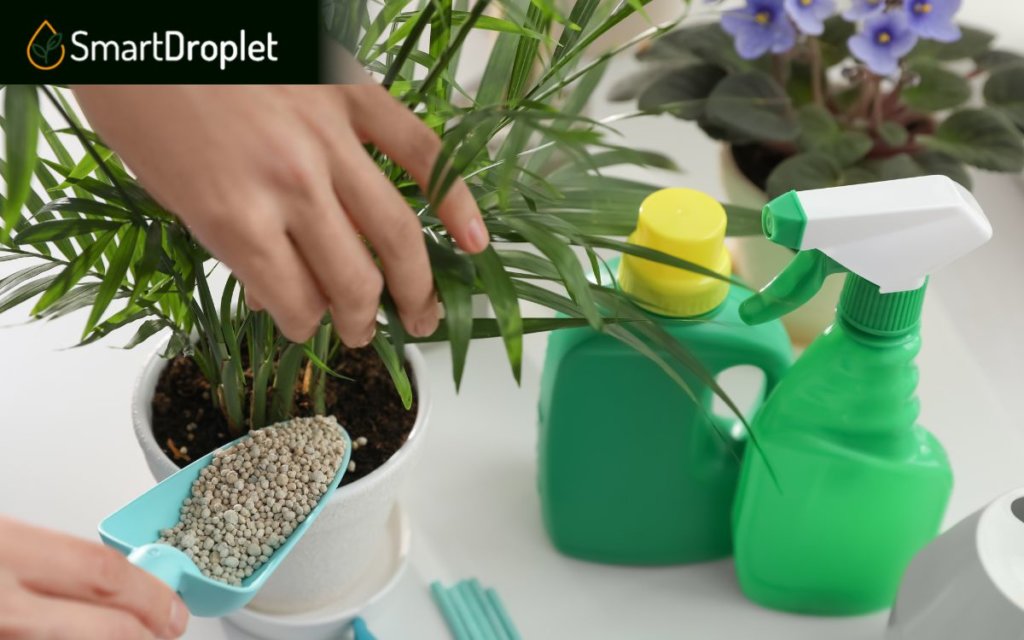
The Disadvantages of Granular Fertilizers
Dry fertilizers aren’t perfect. Here are some of their cons:
Needs Lots of Water
Any pellets you spread will require a large amount of water. This is mainly to make sure that the roots of your grass can absorb the nutrients properly.
This adds a considerable water bill to the time and effort you spend applying the granules.
Not Beginner-Friendly
The initial application of dry fertilizer pellets isn’t cut-and-dry.
If you’re using a spreader with a settings dial, you’ll need to adjust it first before you start applying. On top of that, fertilizer pellets are easily-hidden in thick grass.
If you have a larger lawn, you’ll need to chart out your spreader’s path ahead of time so that you don’t accidentally over-fertilize any areas.
Easy to Overdo
Slow-release granular fertilizers also have a high salt content, seriously damaging your grass. Most granular fertilizers are intended to be slow-release, so they’re richer in nutrients.
This makes them great for plant use during the colder seasons, but they can still cause fertilizer burn if used too much.
Takes More Time
Applying granular fertilizer isn’t a quick process. It needs time and effort to fully cover your lawn consistently.
Liquid lawn fertilizer is easy to apply with a garden hose and running water.
On the other hand, dry fertilizers need to be poured into your spreader, and then you need to give your lawn several passes to cover it well.
Once you’re done applying the pellets, you need to retrace your path with a sprinkler or garden hose. Fertilizing your lawn properly can take you an entire afternoon!
How Do I Apply Granular Fertilizer?
The best way to apply granular fertilizer is by using a fertilizer spreader. This tool will ensure that your lawn will get a consistent and even the same amount of nutrients.
If you have a smaller lawn, you can also apply your fertilizer by hand. When choosing this approach, take care to apply the granules consistently.
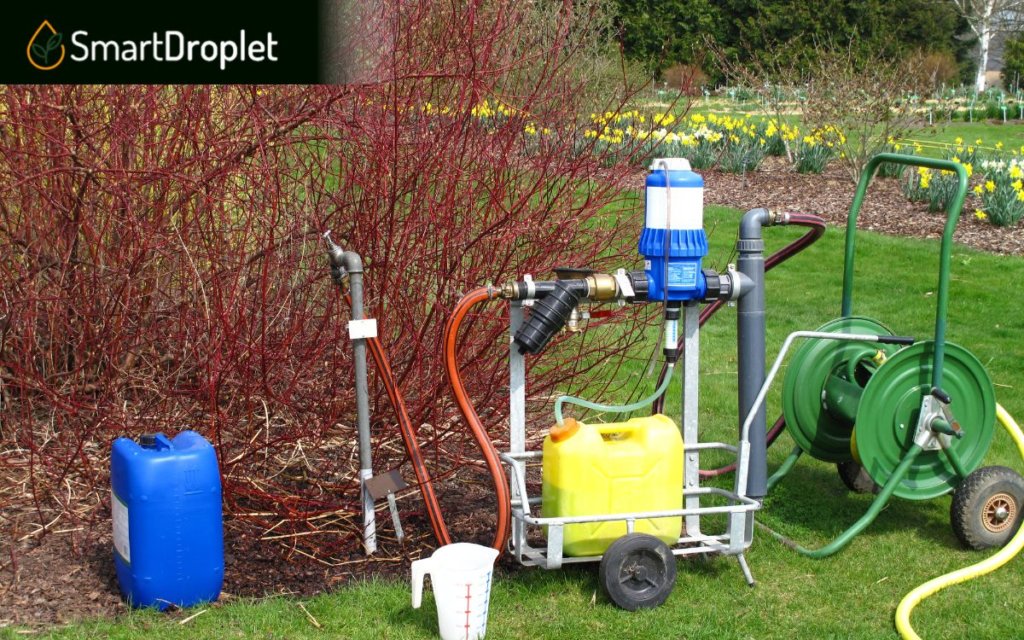
Liquid Fertilizers Explained
These fertilizers are packed with nutrients, and they’ll work faster than granular fertilizers. You’ll only need a trusty garden hose to apply it.
If you’re using liquid fertilizers on a very large lawn, you’ll want to contact a company to get the job done faster.
Spraying liquid nutrients on your plants will ensure that they get their nutrients quicker.
The Benefits of Liquid Fertilizers
Here are some liquid fertilizer pros:
It’s Quick to Apply
The clearest benefit that liquid fertilizers provide is that they are easy to use. As long as you have running water, you can get fertilizing.
Plus, since you’ve got a hose attached, your lawn will be watered and fertilized at the same time! You won’t have to go over your lawn with a clunky spreader, then again with the hose.
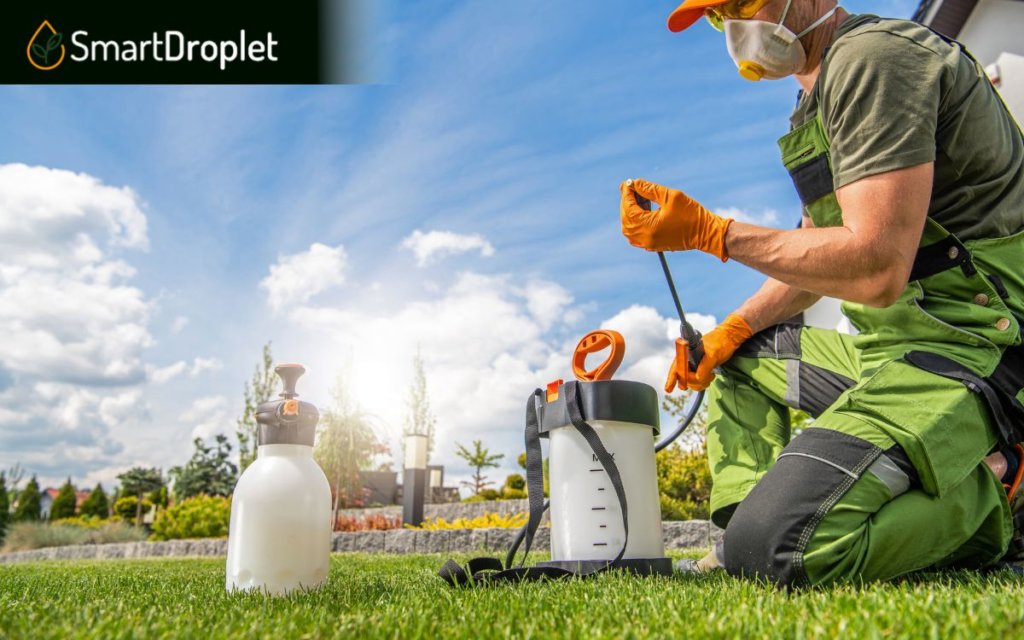
No Need to Wonder Where You Put Your Fertilizer
Unless you’ve got a very keen vision, you normally won’t be able to spot where your dry fertilizer granules have landed, increasing your risk of over-fertilization.
But liquid fertilizers can be blended with a lawn-safe dye that stands out and lets you know exactly where you’ve covered and where to go next.
It’s like having the precision of a drop spreader with half of the effort!
Save Costs on Equipment
As long as you have a garden hose connected to your fertilizer spray, you can immediately move ahead with spraying the lawn.
It’s also easy to find a hose-based spray bottle, so you won’t have to search too hard for an easily-applied liquid fertilizer.
Try this product from Simple lawn solutions:
Blends Well With Other Lawn Care Products
Let’s say you want to apply a selective herbicide and your fertilizer. With the right liquid blends, you can do just that!
Mix them well and get to multi-tasking on your lawn.
Easily Absorbed
This nourishing fertilizer can reach plant roots in no time, meaning you’ll see their effects even faster than with dry fertilizers.
The Issues With Liquid Fertilizer
This solution comes with its drawbacks. Here are a few:
Short-Term Results
You’ll likely need to apply feed to your lawn more often throughout the season because of how quickly most liquid fertilizers spread their nutrients.
But this speed comes with its problems. If your lawn experiences too much growth briefly, this can hamper root growth.
This rapid growth can make your lawn less resistant to pests, stress, and diseases.
Can’t Be Stored for Too Long
Unlike fertilizer pellets, liquid blends can separate when stored for too long. This will give you a much less effective solution of inactive liquid.
Spraying this on your lawn can damage your grass, so you store your fertilizing solution properly.
More Expensive Than Granular Fertilizer Products
The ease of use comes at a cost, and pairing this expense with constant re-applications makes for a very pricey lawn.
If you have a larger lawn, stick to granular fertilizer!
Is Easily Affected by Weather
Take care on windy days because the weather can spray your solution in different directions and cause over-fertilization in the worst case.
How Do I Apply Liquid Fertilizer?
Please take note that fertilizing solutions will often come in concentrated form, so before you attach your standard spray bottle, you’ll need to make sure you’ve diluted it enough.
Liquid fertilizers can be applied in two different ways:
Ground Applied
The ground application requires a bit of timing because you’ll need to do it before your grass seed begins to sprout.
Just spray the liquid fertilizer of your choice straight onto your lawn. The quick-release fertilizer will take care of the rest.
Applying liquid fertilizer with this method is best done during spring and summer to take advantage of the spring growth period.
Avoid applying liquid lawn fertilizer during the fall or winter because there isn’t a lot of vegetative growth happening during those seasons.
Foliar Applied
If your lawn’s growing season has already passed, you’ll have to rely on foliar applications instead. This is where liquid fertilizers shine.
Since you don’t need to apply liquid lawn fertilizers directly to the ground, you can spray them directly on your grass, even after sprouting.
“Foliar application” is just a fancy saying, “Spray the leaves directly with liquid fertilizer.” This works because you’re spraying fertilizer in liquid form.
FAQs
More lawn care questions are answered here!
Which Is the Best Kind of Fertilizer?
Both granular and liquid fertilizers blends will contain the three basic nutrients essential for lawn care: Nitrogen, Phosphorous, and Potassium.
Putting all of their other differences aside, this means that to your plants, the nutrients supplied won’t change whether you use dry or liquid fertilizer.
You can use both liquid and granular fertilizers on your lawn, depending on the season.
When Should You Apply Fertilizer?
The answer to this question will depend on the grass seed you’ve planted.
If you have warm-season grass, you should schedule their fertilizer application for the warmer months, in spring and summer.
But if you’ve planted cool-season grass seed, your lawn will need fertilizer in fall and spring.
What Happens if I Over-Fertilize?
Both liquid and granular fertilizers need to be used in moderation. While using fertilizer is an important step in lawn care, it’s still possible to overdo it.
The primary effect on your lawn is that the main nutrients in your soil will be thrown out of balance.
In particular, the levels of nitrogen and salt within your lawn will reach levels that your grass seed won’t be able to tolerate.
When this happens, your entire yard could suffer damage or even die.


